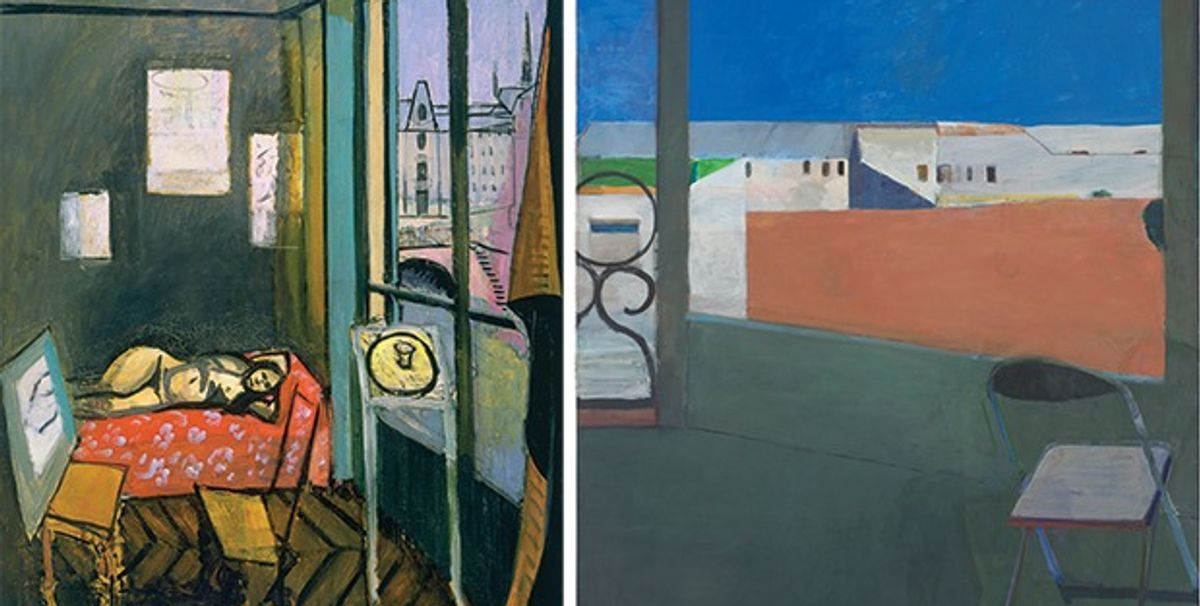Anyone passingly familiar with the art of Richard Diebenkorn knows of his acknowledged debt to Henri Matisse. The exhibition Matisse/Diebenkorn at the San Francisco Museum of Modern Art (SFMoMA) tallies that debt as no other curatorial project has before, thematically grouping 100 paintings (40 by Matisse, 60 by Diebenkorn) and a few drawings by the two, who never met.
Despite the bounty of exemplary works that it contains, Matisse/Diebenkorn generates an uneasy mood that we might call the anxiety of corroborating influence. It argues most persuasively that Diebenkorn took permission from Matisse to luxuriate in colour (although a room full of charcoal and ink drawings by both artists presents the only real risk of confusing the two).
Wall texts and catalogue essays convey that Diebenkorn (1922-93) saw in Matisse (1869-1954) an authoritative precursor to his own ambivalence about Modernist problems such as expressive sincerity, formal resolution and the ratio of self-knowledge to self-invention that works of art appear to embody.
On almost all such pivot-points, Matisse appears the more poised of the two artists—more trustful of himself and more confident of the cultural ancestry from which he descended. Diebenkorn had his first formative encounter with Matisse’s art in 1943, while still a Stanford University undergraduate.
Recognising his gift for painting, a faculty member arranged for Diebenkorn to visit the Palo Alto home of Michael and Sarah Stein (the brother and sister-in-law of Gertrude Stein), who were major collectors of Matisse’s work. Matisse’s 1916 portrait of Sarah, which SFMoMA owns, appears in the first room of the exhibition, serving as a talisman of Diebenkorn’s great moment of discovery.
A Marines enlistment programme permitted Diebenkorn to complete his Stanford studies before going east for basic training. Stationed in Virginia in 1944 with his new wife Phyllis, he visited the Phillips Collection in nearby Washington, DC, at every opportunity. He was on the verge of being shipped to the Pacific to participate in the planned invasion of Japan when the destruction of Hiroshima and Nagasaki by American atomic bombs forced Japan’s surrender. The grim probability that his life had been saved by humanity’s most horrific invention never left Diebenkorn, according to Jane Livingston, the co-editor of the recently released four-volume catalogue raisonné of his work.
A painting from the Phillips Collection called Studio, Quai Saint-Michel (1916) by Matisse comes into view at the exhibition’s entrance, appropriate to its seminal impact on the young Diebenkorn. It invites visitors to locate echoes of Matisse throughout Diebenkorn’s work, but few appear in the American artist’s early abstractions in the same gallery. These works present roiling colour and line from which it seems any subject might emerge. Far more readily than anything we see in Matisse, they evoke a readiness to follow any lead that the tussle with materials might suggest.
When, in the mid 1950s, Diebenkorn followed the lead of his friend and mentor David Park (1911-60) in renouncing abstract improvisation for images inspired by everyday creative life, he also carried forward Matisse’s treatment of space as a terrain in which subjects and inventions may intersect.
With a few glorious exceptions (notably the imposing Seated Woman from 1967), Diebenkorn’s pictures incorporating human figures suffer in comparisons with Matisse. Diebenkorn’s figures, done from memory or imagination, tend to look as lifeless as furniture. Ironically, an empty chair, recurrent in Diebenkorn’s work—another borrowing from Matisse’s Studio, Quai Saint-Michel—electrically evokes his restless authorship, wish for detachment, even his inevitable death.
My second visit to the show brought to mind a striking remark by the English critic Cyril Connolly: “It is closing time in the gardens of the West and from now on an artist will be judged only by the resonance of his solitude or the quality of his despair.”
Matisse/Diebenkorn seems inadvertently to position the two artists within and without “the gardens of the West”, which includes a pictorial tradition capable of nourishing innovation, hope for civilised life and a promise of Arcadian respite. Some of Matisse’s paintings of the 1910s here, such as View of Notre Dame (1914), Goldfish and Palette (1914) and French Window at Collioure (1914) continue to stun by their asperity and uncertain finish. But thereafter his pictures, even withdrawn indoor scenes such as Interior, Flowers and Parakeets (1924), resume his dream of art as consolation for the difficulties of life.
On the other hand, the constrained turbulence of Diebenkorn’s early abstractions, the implicit anomie of his finest figurative paintings and even the gate-like lattices of the great Ocean Park paintings all give off vibrations of expulsion from some garden.
Livingston, the catalogue raisonné scholar, took her audience at the San Francisco Art Institute by surprise when she recently claimed that Diebenkorn’s deep preoccupations were “rage at human nature and grief at history”. Yet the remark must ring true to all who knew the man even slightly, as I did.
The show’s crescendo comes with an array of Diebenkorn’s Ocean Park works. With these paintings, beginning in the late 1960s, Diebenkorn found an idiom in which to dramatise painting as a vital response to its time. The series hums with tension between the materials at hand—brushes, paint, charcoal and the palimpsest that the blank canvas had become by mid-century—and the urgency of a perilous future.
Kenneth Baker retired in 2015 after 30 years as resident art critic for the San Francisco Chronicle. He is a regular contributor to The Art Newspaper
Matisse/Diebenkorn, San Francisco Museum of Modern Art, until 29 May


